
From ‘Imperial Gazetteer of India,’ v. 26, Atlas 1931 edition, Railways & Inland Navigation, p. 50. Used here under a Creative Commons Licence (CC BY-NC-ND 3.0). [4]



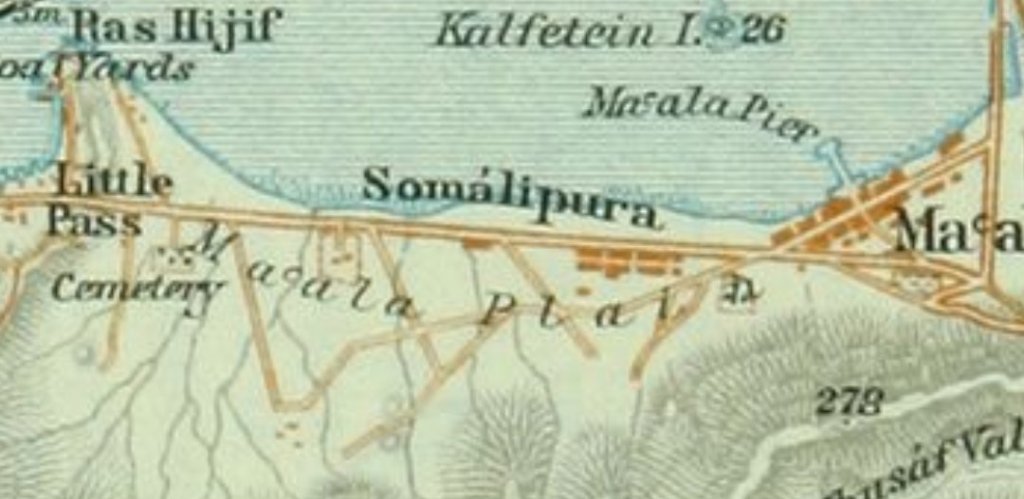
The Aden State Railway operated for just 13 years or so, from 1916 and 1929 in Aden, a dependency of the Bombay, British Colony and Protectorate, in the south-west corner of Southern Arabia. The metre gauge railway was 29 miles(46km) long and was worked by the North Western Railway [3] of India under one of its officers who was designated ‘Engineer-in-Charge’. [1][2]
This was not, however, the first railway planned for Aden. As early as 1906 a light railway from Aden to Dthala (Ad Dali),120km inland had already been under consideration but nothing had materialised. [5]
There was a precursor to that line as well. Simon Darvill explains: “Following the end of the Abyssinian campaign in 1868, some of the railway equipment that had been used on the campaign was sent to Aden. It comprised of two locomotives, two carriages, two brake vans, 20 trucks, 480 rails, 3,250 chairs, 516 fishplates, 6,553 sleepers and two turntables. The equipment was unloaded in [July & August] 1868; it is thought to have been delivered on the ship Californian that left Abyssinia on 10/6/1868. A small shed and workshop was constructed in which to store the equipment. The intention was to build a railway from the pier head to the post office and possibly on to the cantonment. The line was considered to be a purely military venture and was not expected to pay its own expenses and that the main traffic would be Commissariat Stores. The 1869-70 annual report stated that it was still the intention to build the line and that the equipment was still in store in Aden. The last mention of the equipment found in the annual reports was in the 1872-73 report when the payment for a watchman for the railway plant was listed in the accounts for 1871-72. A reference appears in the Railway Stores Department records concerning correspondence on 28/2/1871 between the Bombay Government and the Military Department regarding the disposal of the equipment in Aden but unfortunately the actual correspondence appears to no longer exist. It is therefore impossible to say with certainty what happened to the equipment but it is suggested that it was either returned to India or scrapped sometime in 1871 . It is similarly impossible to say for certain which two of the six locomotives that were used in Abyssinia were sent to Aden” [20: IA34]

The next reference to a proposal for a railway that I have been able to find is a draft proposal put forward in November 1905 to the Sultan and the British Government by Lieut-Colonel R. Leigh, R.E., Assistant Commanding Royal Engineer who had been engaged in drawing up the line and at the time touring within Abdali limits between Dar-Al- Amir and Nobat Dakim for that purpose. [15: p126] A map was included in the submission and is probably that which is archived at the Qatar Digital Library (Ref No.: IOR/L/PS/10/89, f 114) which can be examined on-line. [21] The map shows the path for a proposed railway to be built from Aden to Nobat Dakim (Nawbatal-Dakim, Yemen; identified four miles north of Al’Anad but not corresponding to any place). The map was zincographed by the Vandyke Process at the Survey of India Offices, in Calcutta and its use here is authorised by the Qatar Digital Library. It covers the area shown below:

This sequence of three plans shows the proposed railway route. Please note that the map extracts are not all to the same scale. ….

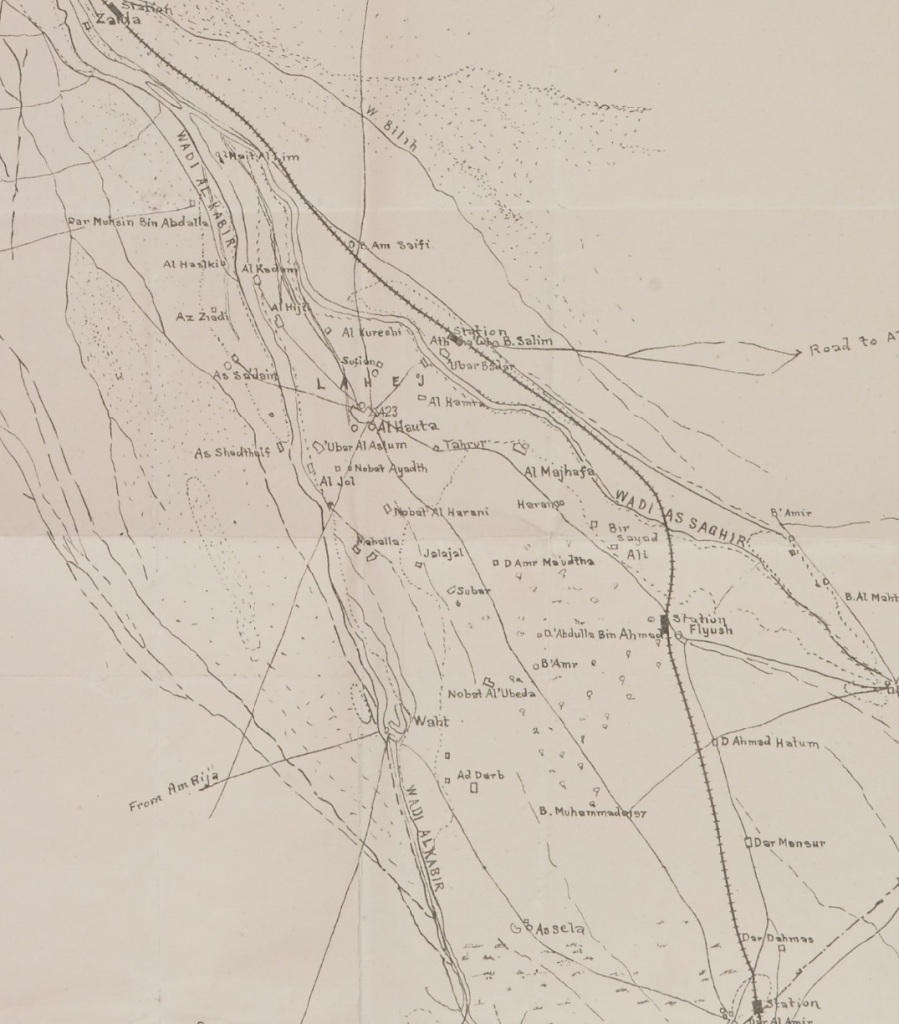
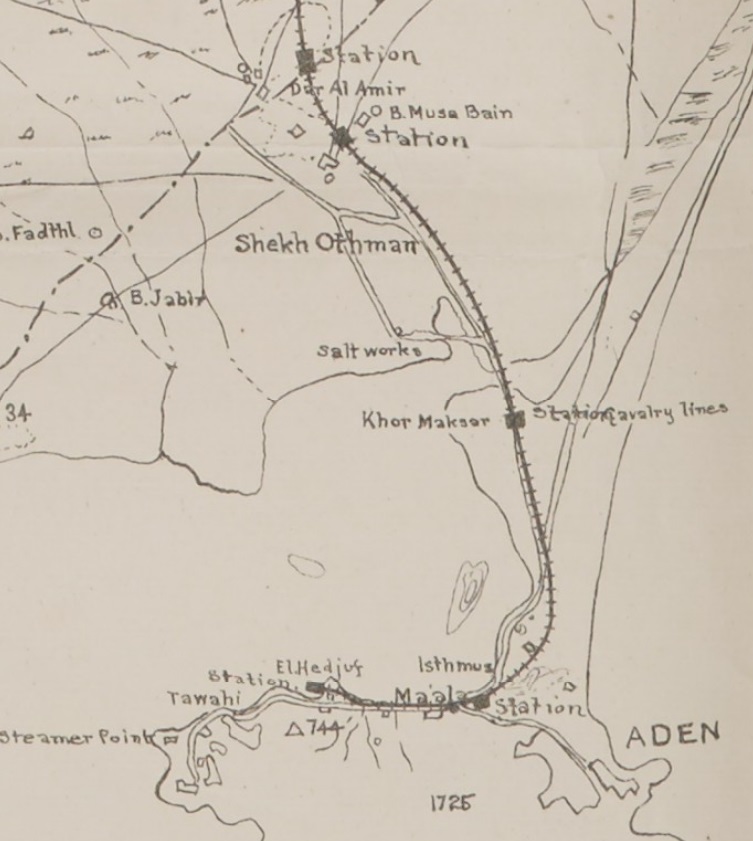
It is important to remind ourselves that the images above relate to a proposed railway from around 1905/1906 and that they cannot be assumed to relate directly to the line which was eventually built by the military. However, it is possible that, the survey undertaken for this proposed line would have informed decisions taken at a later date. It is unlikely that the tunnel referred to by Leigh (see the next paragraph) would have been part of the route chosen by the military as construction costs would have been minimised in times of war.
In his report, Leigh suggested:- “That the line would follow the road and that way would limit the expense of bridges, with an even slope and without valleys or hills. In Aden, it is suggested that a station should be located south-west of Maala, and a small branch line run to Maala Wharf. From Maala the best line seems to be to tunnel under the hill and run out through the Small Isthmus. Stations are also proposed at Khormaksar and Sheikh Othman. It would be a great convenience to extend the line from Maala to Steamer Point which can be done by running the line on the north side of the main road with a terminus on the newly reclaimed land at Tawahi.” [1][15: p108a-109a] However, as can be seen from the plans above, the submitted proposal did not actually take the line to Steamer Point.
Major General H. M. Mason, Political Resident at Aden, supported the proposal. Aden Chamber of Commerce urged the Government to facilitate the construction of the railway. [1][15: p104] No progress was made, however, as the British Government opposed the construction on political grounds. [1]
Some years later, on 30th May 1911, Lord Lamington asked the Secretary of State for India for information about a French syndicate railway to be constructed from Hodeida (on the West coast of Yemen) to Sana’a (the capital of Yemen), and whether all idea of railway extension in the Aden Hinterland had been abandoned. He also asked about progress in the dredging of Aden Harbour. [6]
He said, “Some eight or nine years ago, after the conclusion of certain operations in the Aden Hinterland, the Government had under consideration a project for the construction of a railway from Aden to the high ground in the Hinterland to a place called Dthala. … But the policy … was to withdraw altogether from the Hinterland. …. Therefore any consideration of a railway lapsed. At the same time the Chief of Lahej had granted one or more concessions for a railway to a company who wished to construct what would have been a portion of the bigger scheme—from our Aden frontier at Shaikh Othman to his capital—but even this railway was prohibited as coming under the grounds for withdrawal. … It was obvious that if the railway was not carried on to Aden it would be of no value at all.” [6]
Lord Lamington continued, “A few days ago I saw in the Press a statement that a railway syndicate was beginning to construct a line from Hodeida to Sana’a, which is 140 miles inland and is the capital of Yemen. If it is the fact that there is now going to be a development of the southern portion of Arabia, I would ask whether it would not be advisable to reconsider the policy which was adopted … and allow the development of the Aden Hinterland by the great civilising agency of a railway.” [6]
In reply, Earl Beauchamp commented that a concession had been considered for a line East from Hodeida to Sana’a. A survey of the line which “included the construction of a harbour at Ras-el-Ketib and a railway line from Ras-el-Ketib via Hodeida to Mefak (186 kilometres) and thence to Sana’a (85 kilometres), a branch to be added proceeding north-west to Amran (57 kilometres from Sana’a).” [6] He noted that the total cost of the scheme was estimated at £1,772,000 and the Ottoman Government decided not to grant a concession to any foreign company for the proposed line for a limited number of years, but a syndicate had taken in hand on behalf of the Ottoman Government the construction of the harbour at Ras-el-Ketib and the section of the railway to Hujjula. The line was to run via Hodeida (about 116 kilometres).
Earl Beauchamp affirmed that it was “the settled policy of His Majesty’s Government to abstain from any extension of their responsibilities in the Aden Hinterland so long as the status quo [was] strictly observed by the Turkish Government. Any scheme for railway construction would be narrowly scrutinised by them in the light of this policy.” [6]
In respect of the dredging of Aden Harbour some prolongation due to physical obstacles had occurred. Earl Beauchamp stated that, “the latest information we have is a report made by the Port Trust to the Bombay Government in 1910, in which they state that difficulties had been experienced in attempting to remove the rock in the valley mouth on the south side of the channel, and that the dredger had broken down. It was therefore decided to abandon dredging in this particular spot, and to widen the other part of the channel. This alteration in the scheme was approved by the port engineer and the Port Trust, and was sanctioned by the Bombay Government.” [6][7]
Meanwhile, on the peninsula a 2ft. 6in. gauge tramway serving the City and its port had been considered. It is possible that the construction of that tramway might have met much of the perceived local need in the area between Crater, Sheikh Othman and Tawahi (Steamer Point). Robert Mumford quotes a report to the British Resident, Aden by a Mr Affleck in which he opined that “if the Tawahi (Khormaksar-Sheikh Othman)-Crater tramway were built, Sheikh Othman should develop into a large town and the combined railway and tramway should be a sound commercial proposition. However this tramway never materialised.” [12]
Details of a later 2ft. gauge tramway serving the Port of Aden can be found on the following link:
Aden Port Trust Tramway … and other things?
It was not until after hostilities commenced in the First World War that permission was given for the construction of a metre-gauge line North from Aden.
Pickering tells us that “in 1915 the CRE (Commander, Royal Engineers) requested permission to lay down a light railway from Aden to Sheikh Othman to supply the British forces fighting against the Turks, with the intention of extending it to Lahej once it was back in British hands. Approval was given and a 1000mm gauge military railway was built by the Royal Engineers. By December work was completed on the new railway providing a quick and efficient way to move troops and equipment to the Sheikh Othman defences. In 1919, the Aden Government approved the extension to Lahej. The 46.3 km line was made available for public traffic in 1922.” [5]
Sheikh Othman was only a short distance from Aden, even so early in the War, British control had been allowed to lapse to allow a focus to be made on defending the main settlement of Aden itself. Once the decision to retake Sheikh Othman was made on 16th July 1915 it was only a few days before it happened. Sheikh Othman was retaken on 21st July and construction of the railway soon commenced. It was completed as far as Sheikh Othman by December. [8: p256] The railway was opened as far as Lahej by February 1919, [8: p257] and Al Khudad the following year, giving a total length of line of 29 miles (46 km). [10] Plans to extend the railway to the protectorate’s frontier never bore fruit. [13] The line eventually closed in 1929 and was lifted by 1930. [1][17]
In his article, Rainbow focusses on the years of the First World War. He talks of the significance of the railway to the prosecution of the War on the Arabian Peninsula.”On 12th January 1916, 1,138 rounds were fired in one day, being the greatest number in the campaign. This had been unthinkable before the arrival of the railway. [8: p257][9]
Steve Llanso says that the Locomotive Magazine report [11][13] focused on water supply, beginning with the general observation that “Fresh water is scarce in Aden, being obtained chiefly by condensation …Much of the water used by the locomotives is taken from a small river near Lahej.” [13] Llanso comments that the limited water available was was stored in ancient storage reservoirs as well as wells further away from Aden and “delivered through an aqueduct seven miles long.” [11][13] An aqueduct supplying Aden is shown on the map below.

Eljas Pölhö notes that the railway carried passengers, grass, charcoal, green vegetables, potatoes, skins and other goods from Yemen to Aden, and also large quantities of water for the army outpost at Sheikh Othman, which included a mobile force of cavalry and a camel corps. To carry water, the railway was extended to Hassaini Gardens, 13 kms north of Lahej.” [16]
Robert Mumford tells us that, “In the early twenties the railway was bedevilled by both labour and sabotage problems, the first being possibly due to the fact that it was administered by mainly Indian personnel, whereas the operational manual tasks were carried out by mainly Adenis, Yemenis and Somalis. Sabotage and pilfering reached such proportions that in August 1920 the Chief Police Commissioner wrote to the First Assistant in the British Resident’s HQ that Mr. Affleck had requested a much-increased security staff.” This enhanced security was provided in the form of 9 personnel based at Maala Depot and at Sheikh Othman Depot, but this security probably became an increasing financial burden on the railway and the State.” [12]
In August 1928, the Political Resident, Aden, advised the Railway Board at Simla (India) that the conclusion had been reached that the railway could not become a paying concern and should be closed down but not immediately, the present service to be reduced by 1st October to one train each way daily between Maala, Lahej and Al Khudad, and maintained till 31st March 1929. Mumford continues: “About the same time the Colonial office advised the Ministry of Defence that the section from [Maala] to Khormaksar was of military importance, and should remain; the section from Khormaksar to Sheikh ‘Othman had a potential military value only for the protection of water borehole supplies at Sheikh ‘Othman; and the section beyond Sheikh ‘Othman had no military importance and should closed as from 1st April 1929, but it would not be dismantled immediately.” [12]
Records relating to the construction and dismantling of the Aden State Railway are held in the India Office Records at the British Library. [15] The Families In British India Society (FIBIS) tells us that an on-line search of the IOR records relating to this railway gives a number of entries, the most significant being:-
- L/PS/10/89 “File 379/1906 ‘Railways: Aden; railway construction in Aden hinterland; Aden-Lahej Railway’; 20 Aug 1904-3 Apr 1922”. The Catalogue Contents state ‘… relating to proposals for the construction of a steam railway between Aden and its hinterland from 1904…..’
- R/20/A/… The search gives at least 8 Records concerning ‘Tramways and Railways in Aden and the hinterland’ dating from 1904 through to 1921
- R/20/A/3232 “File 523 Proposed discontinuance of the Aden railway service; 1928”
- L/PS/10/703/1 “File 3082/1917 Pt. 16 Aden: railways; 1928-1930” [1]
I have only looked at the first of these references.
As we have already noted the line was closed in 1929. The process of lifting it may have taken a while as, in 1932, “the Secretary of State for India wrote to the Chief Commissioner, Aden asking if the railway equipment was still available, as they had received an enquiry concerning its purchase. The Chief Commissioner replied the railway had been sold to George Cohen & Co Ltd, London who had cleared the site by 27th August 1932.” [20: IA35]
Rolling Stock and Motive Power
Rainbow says that, “Most of the rolling stock and equipment for the Railway came from the Bombay, Baroda and Central India (B.B.C.I) Railway.” [8: p257] Shortly after its completion, the railway was transferred into civilian control. [10] Rainbow continues: “The Aden Railway was worked by the North-Western Railway of India who supplied one of its officers as ‘Engineer-in-Charge’. The B.B.C.I supplied three class F1 0-6-0 locomotives being numbers 288 (Neilson & Co., 1879), 349 (Neilson, 1880) and 727 (Dubs, 1894). They also supplied two first/second composite carriages, four third-class carriages, all being bogie vehicles, three brake vans, 12 high-sided and 56 low-sided wagons and one oil tank wagon. In 1916 the South Indian Railway Railmotor (No. 3 of 1916) arrived.” [8: p257][2]
It seems that, in addition to the three B.B.C.I 0-6-0 locomotives, the East Bengal Railway supplied a further 3 No. 0-6-0 locomotives. [13]
In 1922, just as the line opened to its fullest extent, [13] Nasmyth Wilson supplied a 4-6-0 locomotive of a standard Indian State Railways design to the Aden State Railway. Illustrations appeared in the February 1928 edition of Locomotive Magazine. [11] There was also a short article in the Railway Magazine of February 1976 about the Aden State Railway which included a photograph of the Nasmyth Wilson locomotive at Maala. [12]
Steve Llanso provides commentary on the Nasmyth Wilson locomotive and a full set of statistics. [13] The locomotive was the only one in its class. It had Walschaert valve gear and was an oil-burning locomotive. It used Holden’s system of oil-burning in a Belpaire firebox. The engine weighed 81,312lbs, the tender 51,520lbs. Its maximum axle-weight, 21,392lbs. [13]
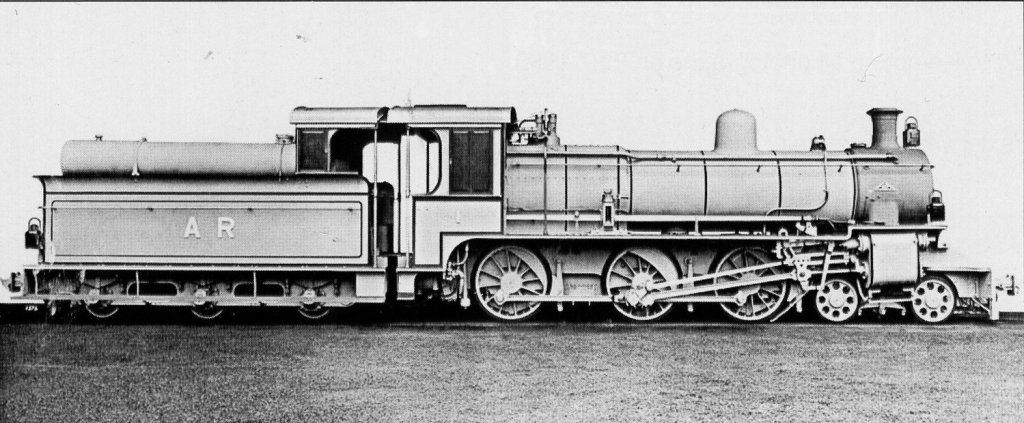

When the line closed, the Nasmyth Wilson locomotive made its way back to India and served the Eastern Bengal as their No. 325 from 1931 on. A change of flag occurred during the 1947 Partition of India when Bengal was taken into East Pakistan. East Pakistan’s independence secured in 1971, its railway still operated No. 325 in 1973. [13][17]
Mumford provides a slightly different assessment of locomotive provision on the line: When it opened “in 1916, two 4-4-0 engines were transferred from the Eastern Bengal Railway (Nos. 561 and 563) and three of the same type from the Bombay, Baroda & Central India Railway (Nos. 228, 349 and 727) … A Simplex rail motor coach with Dorman four-cylinder petrol engine built for the South Indian Railway was also put into service, making six trips daily to Sheikh ‘Othman with seating for 70 passengers.” [12]
It seems as though there is a measure of confusion over which locomotives were provided. Mumford was corrected by Hugh Hughes in The Railway Magazine of April 1976: “May I point out that the reference to 4-4-0 engines being used there is incorrect. Mr. Mumford may well have been misled by an error in an article in the ‘Locomotive Magazine’ for February 1928. For working the line, the Bombay, Baroda & Central India Railway supplied in 1915 three of its class ‘F1’ 0-6-0 locomotives, with 3ft. 71/2in. coupled wheels and 14 in. x 20 in. cylinders; they were numbered 288 (built by Neilson & Company in 1879), 349 (Neilson 1880) and 727 (Dübs, 1894). … Three similar 0-6-0 locomotives, but emanating from the Eastern Bengal Railway, put in an appearance later on. Two of them, numbered 561 and 563, had been used by the military authorities in East Africa from 1916 onwards; no. 563 (Vulcan Foundry 1900) was transferred direct from Africa to Aden, probably in 1919, but 561 (Neilson 1898) was first of all returned to India and reached Aden in 1920. The third EBR engine was numbered 584 (not 684 as given by Mumford); it was also built by Neilson in 1898 and was transferred to Aden about 1926. As far as I can trace, none of these 0-6-0 engines worked again after the closure of the railway at the end of July 1929.” [19]
The most authoritative information about locomotives and rolling stock on the line can be found in the Industrial Railway Society’s book, “The Industrial Railways and Locomotives of India and South Asia” compiled by Simon Darvill. [20]
Darvill says that, “The BBCIR supplied the following rolling stock in 1918 for the railway in Aden: six 1st/2nd class bogie composite carriages, two 38 foot bogie 3rd class carriages, four 38 foot 6 inch bogie 3rd class carriages, three brake vans, 12 high sided wagons, 28 end open wooden low sided wagons, one MG riding trolley, a ten ton crane and runner and an engine shed. In the Railway Stores Department records it is stated that in [December] 1919 six steel top wagons (with spares) and 14 miles of track of unknown gauges was supplied to the General Officer Commanding, Aden for use in a stone crushing installation. It is assumed that this was supplied as part of the extension of the Aden Railway to El Khudad, which opened in [January] 1920. In the [April] 1918 Railway Stores Department report there is a note on the question of the supply of a Simplex motor tractor to Aden. It is assumed that this was for use with the stone crushing plant but further details are unknown.” [20: IA35]
He also provides details of the motive power on the line. There were six 0-6-0 tender locomotives:
• No. 288, F Class built in 1879 and transferred from the BBCI Railway in 1915.
• No. 349, F Class built in 1880 and transferred from the BBCI Railway in 1915.
• No. 727 F Class built in 1894 and transferred from the BBCI Railway in 1915.
• No. 561 F Class built in 1898 and transferred from the Eastern Bengal State Railway (EBSR) in May/June 1919.
• No. 563 F Class built in 1900 and transferred from East Africa in 1916.
• No. 584 F Class built in 1898 and transferred from the EBSR early in 1921.
Hugh Hughes mentions Nos. 288, 349 and 727. He asserts that they were moved to Aden in 1916. Apparently, all the BBCI Railway Class F 0-6-0 locomotives had been refurbished by 1914 and were regarded as sub-class F1. He is unable to offer pictures of the locos. The first two of these locos had 13.5 in. diameter cylinders and a 10ft. 3in. wheelbase, whereas No. 727 had 14″ diameter cylinders and an 11ft wheelbase. [23: p42]
Hughes notes that No. 561, No. 563 and No. 584 had 14 in. cylinders. [23: p53]
All six were sold to George Cohen & Co Ltd, London and removed, by August 1932. [20: IA35]
Darvill also records:
• No. 1 as a 4-6-0 F Class built in 1922 supplied direct by Nasmyth Wilson and transferred in 1931 to the EBSR where it became their No. 325. (Hughes notes that the loco had 16 in. cylinders and arrived at the EBSR from Aden. [23: p53])
• No. 3 as a 4-wheel petrol-engined railcar with mechanical transmission built in 1915 which was ordered for South India Railway but requisitioned by the Indian Army for use in Aden. This was also sold to George Cohen & Co Ltd, London and removed, by August 1932. [20: IA35]
Further interesting items of rolling stock were three light railmotors for carrying officers on the line. Details of those railmotors appear in The Locomotive Magazine. [18]

The Service Provided
We have already noted the kind of materials carried by the line. In his article Mumford talks of traffic on the line: “At the height of its existence there were two mixed trains a day which left [Maala] at 07.00 and 14.00, arriving at the terminus beyond Lahej at 09.00 and 16.00. These two trains each returned an hour later. The passenger section of each train was composed usually of eight carriages. The fares were [Maala] to Sheikh ‘Othman, first class eight annas, third class three annas; Sheikh ‘Othman to Lahej, first class one rupee four annas, and third class five annas.” [12]
The Route of the line
The line’s Southern extremity was at the Maala Wharf. Its presence is confirmed in the first image below.

From Maala Wharf the line ran first eastwards and then Northeast as it followed the sea wall. Its actual route cannot now easily be seen on satellite imagery. In addition to the fact that it is now (2022) about 90 years since the line was lifted, there has been land reclamation in the area of the Port of Aden which make estimating its route difficult.

North of the old road bridge off the isthmus it is only possible to make assumptions about the line of the old railway. My assumption, based on practice elsewhere, is that the line probably followed the route of the road North to Sheikh Othman and beyond. The faint dashed-red line on the plan below shows a possible route which primarily follows roads to the Northeast of Sheikh Othman (Shaykh Uthman on the map) and which, at the very top of the extract meets the line of the major highway to the North.
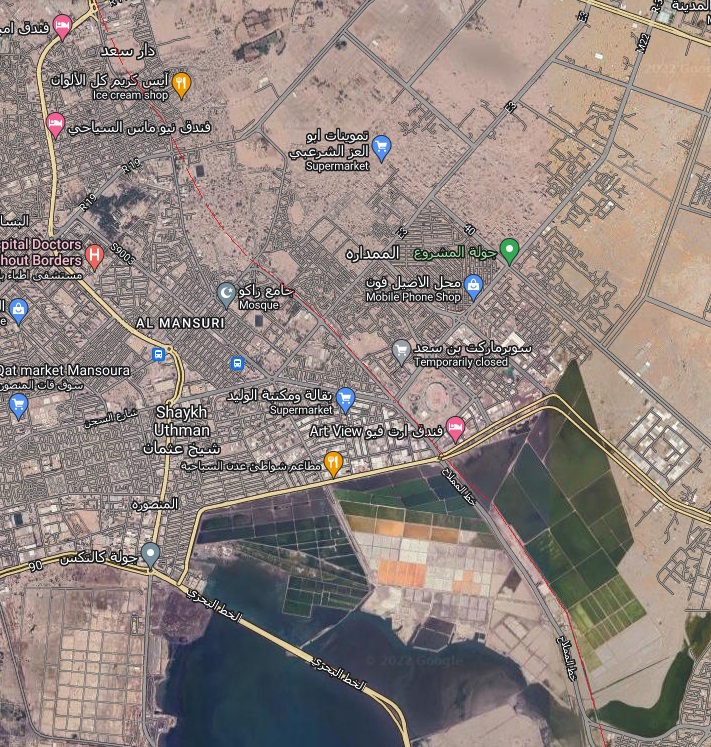
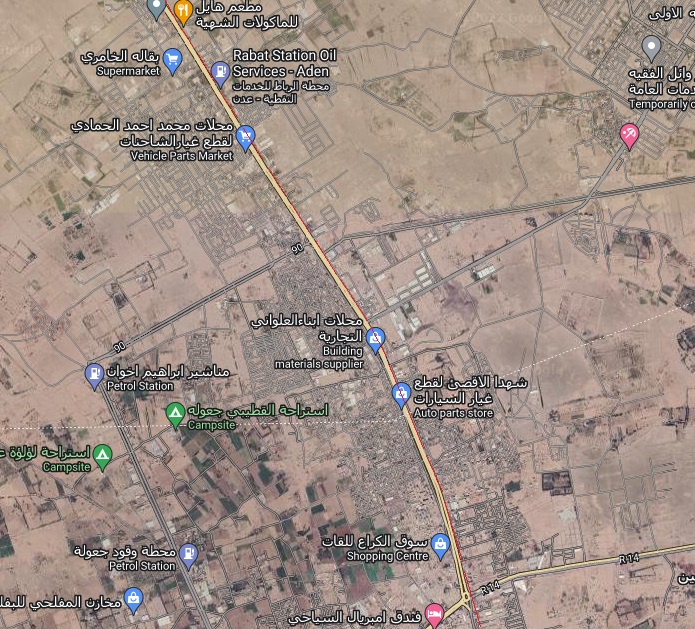
Given that I am making significant assumptions about the route of the old railway it seems best not to try to show the detail of the route and to accept that it has been lost. We know that it served Lahej before travelling further North. If the route proposed in 1905/1906 was used then the line would have been some distance from Lahej at its closest point. The route of the line shown on the map at the head of this article follows the line of the major highway to Lahej rather than the route of the 1905/1906 proposal. The differing alignments are shown below.
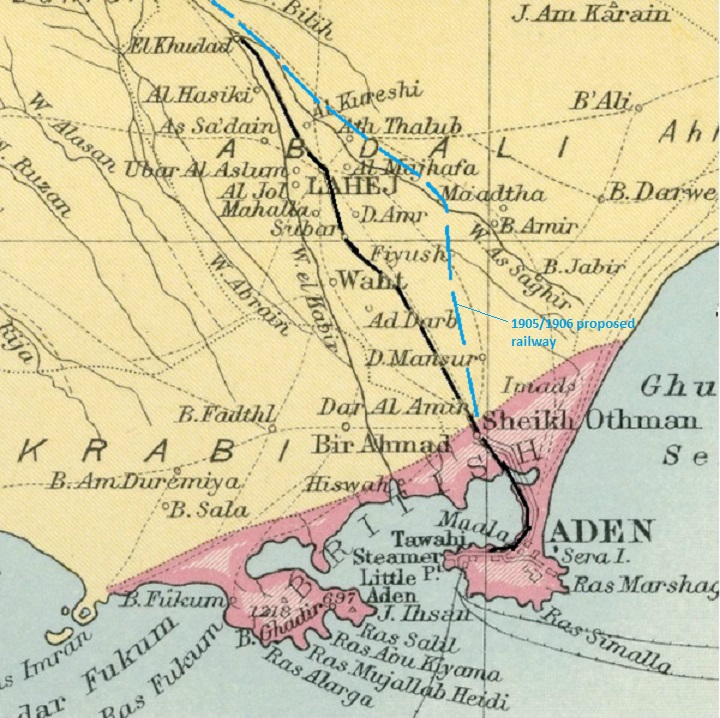
From ‘Imperial Gazetteer of India,’ v. 26, Atlas 1931 edition, Railways & Inland Navigation, p. 50 again. However, I have added the approximate line of the 1905/1906 proposal in light-blue. The image is used here under a Creative Commons Licence (CC BY-NC-ND 3.0).
In summary, we know that the old metre-gauge railway served Maala, Sheikh Othman, Lahej and continued on for a short distance to El Khudad. We do not know the detail of the route it followed.
References
- https://wiki.fibis.org/w/Aden_Railway, accessed on 19th August 2022.
- Robert Mumford; Indian Outpost in Arabia; by in the ‘Railway Magazine’ February 1976 pages 73-75.
- https://wiki.fibis.org/w/North_Western_Railway, accessed on 19th August 2022.
- https://wiki.fibis.org/w/File:Aden_Railway_1931_Map.png, accessed on 19th August 2022.
- https://peterpickering.wixsite.com/aden/railway, accessed on 19th August 2022.
- https://api.parliament.uk/historic-hansard/lords/1911/may/30/the-aden-hinterland, accessed on 19th August 2022.
- https://images.app.goo.gl/L3365VHbftjjAs7C6, accessed on 19th August 2022.
- J. Julian Rainbow; ‘Those Barren Rocks’: The Building of the Aden Railway During World War One; in Paul E. Waters & J. Julian Rainbow; British Military Railways Overseas in the Great War, the British Overseas Railways Historical Trust, Mainline & Maritime, Upper Seagry, Chippenham, 2018, p256-258.
- M. Connelly; The British Campaign in Aden, 1914-1918; in the Journal of the Centre for First World War Studies, Vol. 2, No. 1, 1965.
- https://www.sinfin.net/railways/world/yemen.html, accessed on 19th August 2022.
- Locomotive Magazine, Volume 34, No. 426 (15 February 1928), p42-3.
- Robert Mumford; Indian Outpost in Arabia; in The Railway Magazine, February 1976, p73-75.
- https://www.steamlocomotive.com/locobase.php?country=Aden&wheel=4-6-0&railroad=ar#14421, accessed on 21st August 2022.
- https://www.britishempire.co.uk/maproom/aden/adenmaps.htm, accessed on 21st August 2022.
- British Library – India Office Records IOR/L/PS/10/89 File 379/1906.
- https://web.archive.org/web/20110103164201/http://www.ajg41.clara.co.uk/yemen.html, accessed on 21st August 2022.
- British Library IOR L/PS/12/1462 ‘Disposal of Rolling Stock and Material of former Aden Railway’.
- The Locomotive Magazine 1929, p131. My thanks to Iain Logie for pointing this out to me.
- Hugh Hughes; Reader’s Letter in The Railway Magazine, April 1976, p206. Again, thanks to Iain Logie for this reference.
- Simon Darvill; The Industrial Railways and Locomotives of India and South Asia; the Industrial Railway Society, 2015.
- Map of the Proposed Railway from Aden to Nobat Dakim; British Library: India Office Records and Private Papers, Ref: IOR/L/PS/10/89, f 114; in Qatar Digital Library; https://www.qdl.qa/archive/81055/vdc_100026192896.0x000001, accessed on 23rd August 2022.
- Locomotives International Vol. 133, p32.
- Hugh Hughes; Indian Locomotives part 2 – Metre Gauge 1872-1940; the Continental Railway Circle, Harrow, 1992.

Pingback: Aden Port Trust Tramway … and other things? | Roger Farnworth